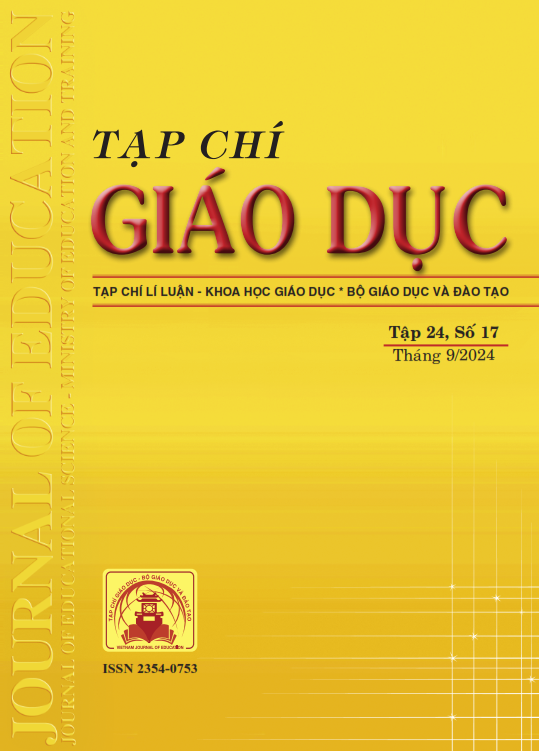Đối chiếu âm vị phụ âm của tiếng Anh và tiếng Việt: Ý nghĩa đối với việc dạy và học ngoại ngữ
Tóm tắt
Different from absorbing the pronunciation of the mother tongue, practicing the correct pronunciation of word units in another language requires teachers and learners to have an understanding of the phonetic characteristics of both the source language and the target language. This paper aims to reinforce knowledge of pronunciation for teachers and learners of English and Vietnamese as a second or foreign language through a contrastive analysis of the two consonant phoneme systems. The method of comparison and contrast is employed to analyze the similarities and discrepancies in the articulatory features of these consonant phonemes. The findings indicate that, despite having 13 similar pairs of consonants, English consonant phonemes display a greater variety of fricatives and affricates in comparison to Vietnamese, while Vietnamese consonants comprise a set of one implosive and two palatalized sounds which are absent in English. Particular challenges and potential pronunciation mistakes that Vietnamese learners of English may confront are anticipated from these findings. The paper also carries some implications for the teaching and learning of pronunciation, including incorporating the analytic-linguistic approach which provides explicit phonetic instructions on the similarities and differences between consonant phonemes of the target and source languages.
Tài liệu tham khảo
Bumpass, F. L. (1963). Teaching young students English as a foreign language. New York: The American Book Company.
Celce-Murcia, M., Brinton, D. M., Goodwin, J. M., & Griner, B. (2010). Teaching Pronunciation: A Course book and Reference guide. Cambridge University Press.
Chu Thị Kim Ngân, Nguyễn Thị Thu Trang, Lê Anh Thơ (2023). Thực trạng và giải pháp đối với việc giảng dạy môn ngữ âm cho sinh viên hệ chất lượng cao năm thứ nhất tại Trường Đại học Kinh tế quốc dân. Tạp chí Công thương. https://tapchicongthuong.vn/thuc-trang-va-giai-phap-doi-voi-viec-giang-day-mon-ngu-am-cho-sinh-vien-he-chat-luong-cao-nam-thu-nhat-tai-truong-dai-hoc-kinh-te-quoc-dan-102529.htm
Derwing, T. M. (2008). Curriculum issues in teaching pronunciation to second language learners. In G. H. J. Edwards & L. M. Zampini (Eds.), Phonology and second language acquisition, 36, 347-369. Amsterdam: John Benjamins Publishing Company.
Ha, C. T. (2005). Common pronunciation problems of Vietnamese learners of English. VNU Journal of Foreign Studies, 21(1), 35-46.
Hinofotis, F & Baily, K. (1980). American Undergraduate Reaction to the Communication Skills of Foreign Teaching Assistants. TESOL “80: Building bridges: Research and practice in TESL”, Alexandria, V.A.
Hoàng Thị Châu (2009). Phương ngữ học tiếng Việt. NXB Đại học Quốc gia Hà Nội.
Lê Thị Thu Thủy, Trịnh Thị Thủy (2023). Các yếu tố ảnh hưởng đến kĩ năng phát âm của sinh viên năm thứ nhất không chuyên tiếng Anh Trường Đại học Lao động - Xã hội. Tạp chí Giáo dục, 23(18), 52-58.
Mai Ngọc Chừ (chủ biên), Vũ Đức Nghiệu, Hoàng Trọng Phiến (2014). Cơ sở Ngôn ngữ học và tiếng Việt. NXB Giáo dục Việt Nam.
Ngo, P. A. (2009). L1 influence on Vietnamese accented English. Kajian Linguistik dan Sastra, 21(2), 93-104. http://dx.doi.org/10.23917/kls.v21i2.4378
Nguyễn Văn Phúc (2006). Ngữ âm tiếng Việt thực hành. NXB Đại học Quốc gia Hà Nội.
Nguyen, B. D., & Tran, T. A. (2023). An Investigation into Errors in Pronouncing Some English Final Consonant Sounds Made By Third-Graders at Tran Cao Van Primary School, Da Nang City. International Journal of Arts Humanities and Social Sciences Studies, 8(11), 78-91.
Nguyen, T. L. (2019). Enhancing Pronunciation Teaching in the Tertiary EFL Classroom: A Vietnamese Case Study. Doctoral thesis, Victoria University of Wellington.
Nu, D. T. (2015). Application of Contrastive Analysis in teaching English pronunciation to Vietnamese adults. EPIP4 4th International Conference on English Pronunciation: Issues & Practices, Prague, Czech Republic, 30-33.
Phùng Thanh Loan (2021). Đối chiếu nhóm phụ âm tắc, vô thanh tiếng Anh trong cách phát âm của người Việt và người Mỹ. Tạp chí Khoa học Ngôn ngữ và Văn hóa, 5(2), 162-176.
Riaño, J. C. P. (2021). Phonetic and Phonological Transfer from Northern Vietnamese to English in Consonant Clusters and Voiceless Final Obstruents. Epos Revista de filología, 37, 185-209.
Roach, P. (2009). English Phonetics and Phonology - A Practical Course (4th ed). Cambridge: Cambridge University Press.
Tran, K. M. A. (2021). An Investigation into Common Pronunciation Errors made by Young Learners. Journal of Science and Technology, 52(04), 78-88.
Tran, T. K. L., & Nguyen, A. T. (2022). Common mistakes in pronouncing English consonant clusters: A case study of Vietnamese learners. Can Tho University Journal of Science, 14(3), 32-39. http://dx.doi.org/10.22144/ctu.jen.2022.040
Vu, H. Y. (2016). Exploring English pronunciation in Vietnam: Time for a new approach. Master thesis, Macquarie University.
Tải xuống
Đã Xuất bản
Cách trích dẫn
Số
Chuyên mục
Giấy phép

Tác phẩm này được cấp phép theo Ghi nhận tác giả của Creative Commons Giấy phép quốc tế 4.0 .












